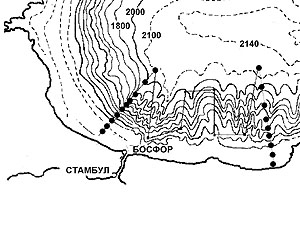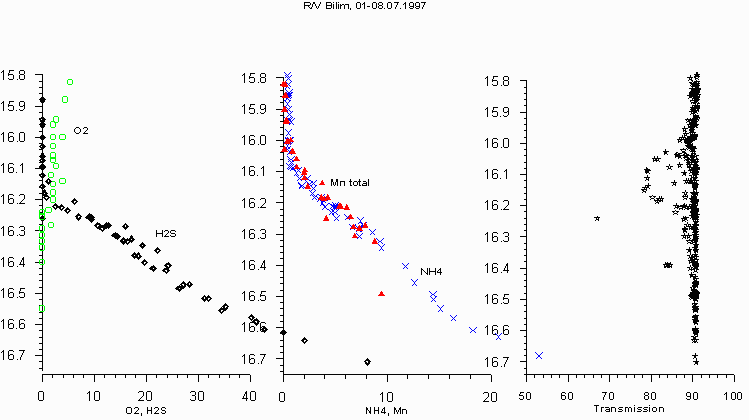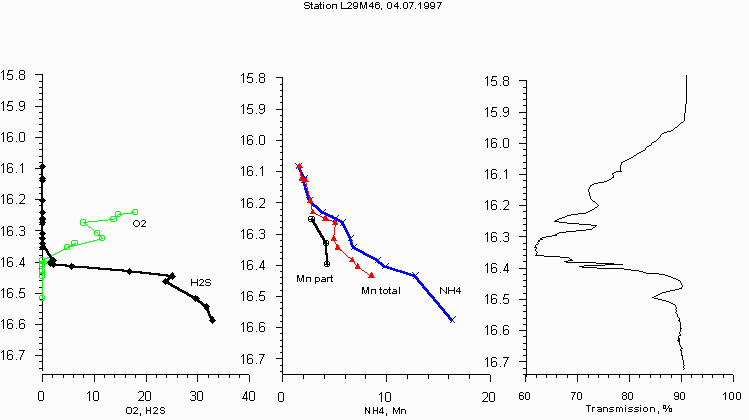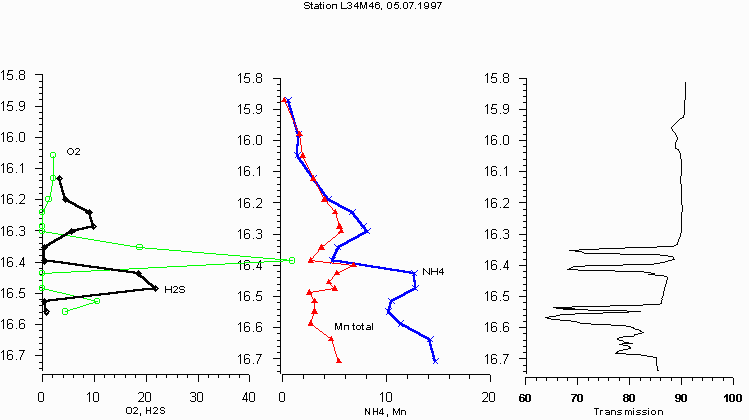r/v"Bilim" cruise to the Southern-Western Black Sea in July, 1997
Fig. 1. Scheme of location of stations made in cruise of R/V “Bilim” on July 01--08, 1997.
The following paper was published in "Oceanology", 1998, N3: International Expedition on Board R/V “Bilim” in July, 1997 in the Black SeaOzden Basturk (1), I. I. Volkov (2), Serap Gokman (1), Hasan Gungor (1), A. S. Romanov (3), E. V. Yakushev (2) (1) Institute of Marine Sciences of the Middle East Technical University, Erdemly, Turkey (2) Shirshov Institute of Oceanology, Russian Academy of Sciences, Moscow, Russia. (3) Marine Hydrophysical Institute, National Academy of Sciences, Sebastopol, Ukraine Received September 01, 1997 An international expedition was carried out in July, 1997 on board Turkish R/V “Bilim”, belonging to the Institute of Marine Sciences of the Middle East Technical University with participation of scientists from the Shirshov Institute of Oceanology, Russian Academy of Sciences and Marine Hydrophysical Institute (Sebastopol). The cruise was carried out from July 01, 1997 (departure from Istanbul) to July 08, 1997 (arrival to Sinop). Chemical and biological investigations were carried out on two sections near the Bosphorus Strait and the mouth of the Sakarya river (the location of stations is shown in Fig. 1). The objectives of the expedition were the following:
In addition, the work was performed to determine the total amount of reaction manganese, and samples were collected at two terminal stations of the sections to determine the isotopic composition of the sulphur in the hydrogen sulphide at levels 300, 500, 750, and 1000 m. Unfortunately, the equipment on board the ship did not allow us to carry out planned deep water stations down to 2000 m. Water samples were collected with the Sea Bird probe equipped with a rosett with 12 five--liter plastic Niskin bottles. The chlorophyll “a” content and transparency were measured together with temperature and conductivity during profiling carried out with the probe. The results of the preliminary processing of the data obtained in the expedition are shown in Fig. 2--4. The vertical profiles of the oxygen, hydrogen sulphide, ammonium, total reactive manganese, and transparency distribution plotted in the density field for each station of the cruise excluding stations L29M46 and L34M46 are shown in Fig. 2. Oxygen measurements (using the Winkler method) and hydrogen sulphide (iodometry) were performed by A. S. Romanov, ammonia (by the formation of indophenol) by E. V. Yakushev, manganese (with formaldoxime) by I. I. Volkov. As it is seen from the figure the obtained density data are consistent with the concept about the vertical structure of the contact zone between the aerobic and anaerobic waters. Thinning out of the deep water hydrogen sulphide takes place at the depths of location of the 16.15--16.20 isopycnals, thinning out of the deep water ammonium and manganese occurs at 16.05--16.10 isopycnals of specific density [1--5]. A well distinguished oxycline is traced down to an isopycnal of 15.60. Below this level the oxygen content gradually decreases down to the isopycnals of 15.90--16.00 at a concentration of 5 uM, and the vertical gradient becomes insignificant. Between the isopycnals of 16.00 and 16.20 the oxygen content is about 3--5 uM. With the appearance of the deep water hydrogen sulphide the concentration of oxygen rapidly decreases to zero. Thus, at the level of the 16.2 isopycnal the concentrations of the hydrogen sulphide and oxygen are about 3 uM. Depending on the criterion which concentrations are considered boundary ones for hydrogen sulphide, on the one hand, and for oxygen on the other we can speak about the layer of existence or the suboxyc layer. If we take the threshold concentration for hydrogen sulphide equal to 0.3 uM which is determined by the photometric method with confidence, and 2 uM (0.04 ml/l) for oxygen, then we can speak about the layer 5--10 m thick. If we take the boundaries as 3 uM for hydrogen sulphide and 10 uM (0.22 ml/l) for oxygen, then we get a suboxyc layer about 30 m thick [5]. Anomalous distributions of the parameters observed near the Sakarya canyon are shown in Fig. 3 and 4. The boundary of the deep water hydrogen sulphide at station L29M46 is located at the depths of 175--180 m, which is characteristic to the anticyclonic gyres (for example, the Batumi eddy) and near shore anticyclonic eddies (NSAE). High oxygen and hydrogen sulphide gradients equal to 1.54 uM/m and 0.38 uM/m, respectively, are observed in the reduction--oxidation zone which are twice as large as usual [3]. At the same time the gradient of ammonium nitrogen is close to the usual one (0.16 and 0.19 uM/m, respectively). The nepheloid reduction--oxidation layer (NRL) is about 100 m thick (from 106 to 204 m) with very high turbidity in its maximum (63% of light transparency). Usually, the NRL is located in the layer of low oxygen with a concentration of oxygen less than 10 uM. The concentration of oxygen at this station even in the middle part of the NRL reaches 20 M with a tendency for increasing to 30 uM at a level of 106 m. Thus, the layer of oxygen deficit is completely absent at this station. It should be noted that there is a great distance (65 m) between the upper boundary of the hydrogen sulphide layer and thinning of high concentrations of deep water ammonium and manganese (usually this distance is about 10 m). An anomalous character of the distribution of the components under study manifests itself more clearly in the density field (Fig. 3). The upper boundary of the hydrogen sulphide layer is located at the levels of isopycnals 16.35--16.40, which is by 0.20 units of specific density deeper than the usual level 16.18--16.20 [1--5]. The maximum of turbidity (transmission minimum in Fig. 3) is located at a level of 16.33 unlike usual 16.08, nevertheless, the thinning of high concentrations of ammonium and manganese took place at 16.05--16.08 as usual. The observed anomalous outline of the distribution of the main characteristics of the reduction--oxidation layer is likely to be a result of a powerful and rapid propagation of oxygen rich waters to the upper boundary of the hydrogen sulphide zone. The situation is apparently unstable, and the typical bacteria community in the reduction--oxidation layer is likely to be destroyed. Due to the increased concentrations of oxygen the oxidation of hydrogen sulphide should be purely chemical with an increased speed relatively to the microbiological oxidation which usually dominates. At the same time the oxidation of ammonium and bivalent manganese which is possible only by the microbiological way is carried out at usual isopycnals with the usual speed in spite of anomalous high concentrations of oxygen. It is difficult to imagine that this situation is stationary. The reasons of the appearance of oxygen rich waters with such high density are not clear. Preliminary analysis aimed to find anomalies in the vertical profile of temperature, salinity and density did not indicate any. On the other station (L34M46, Fig. 4) located 5 miles north of the previous one (L29M46) deep water hydrogen sulphide appears at the levels of 110--115 m, with oxygen concentrations about 3 uM. Two layers (or lenses?) of high oxygen concentration with concentrations of oxygen up to 48 uM (16.40, 158 m) and up to 11 uM (16.52, 190 m) are observed deeper in the layer of waters with hydrogen sulphide. Hydrogen sulphide was not found in these layers. Decrease of ammonium and bivalent manganese is also observed here. Four well pronounced peaks of increased turbidity grouped in pairs are associated with these layers (Fig. 4). Another well pronounced but less sharp layer of turbid waters was observed deeper at the levels of 16.61--16.70. Unfortunately, there are no hydrogen sulphide and oxygen data for this layer. Thus, we observe the appearance of two intrusions (or lenses?) of oxygen rich waters in the hydrogen sulphide zone at station L34M46. In the upper layer we observe a rather high concentration of oxygen corresponding to the lower part of the oxycline (48 uM). It is apparent that the initial content of oxygen in these lenses could be higher, because part of the oxygen was spent on the interaction with hydrogen sulphide, which was most likely carried out chemically. The layers (lenses) containing oxygen are characterized by negative anomalies of temperature (approximately 0.1C). According to the present data there are no anomalies in the vertical distribution of salinity and specific density, but this needs checking. The anomalies described above are of great interest. First, the mechanism of the penetration of oxygen rich waters to the surface of contact between aerobic and anaerobic zones requires explanation. The biochemical influence of this phenomenon on the intensification of interaction between oxygen waters and hydrogen sulphide waters of the Black Sea as a whole depends on the fact whether this phenomenon is widely spread. To our opinion the reason of anomalous distribution of physical and chemical parameters at these two stations may be a peculiarity of the hydrophysical structure in the area of the canyon of the Sakaria river. Detailed research in a study area in this region of the sea are needed to discover the specific features of this phenomenon. |
Parameter/Density curves |

|
| Fig. 2. Vertical distribution of dissolved oxygen, hydrogen sulphide, ammonium, total manganese and transparency in the density field for all stations of the cruise except stations L29M46 and L34M46.
|

|
| Fig. 3. Vertical distribution of dissolved oxygen, hydrogen sulphide, ammonium, total manganese and transparency at station L29M46.
|

|
| Fig. 4. Vertical distribution of dissolved
oxygen, hydrogen sulphide, ammonium, total manganese and transparency at
station L34M46.
|
|
The expedition was organized by the Institute of Marine Sciences of the Middle-East Technical University (Erdemli, Turkey) with participation of scientists from Shirshov Institute of Oceanology (Moscow) of the Russian Academy of Sciences and Marine Hydrophysical Institute (Sevastopol) of NASU. If you want additional information don't hesitate to contact. |